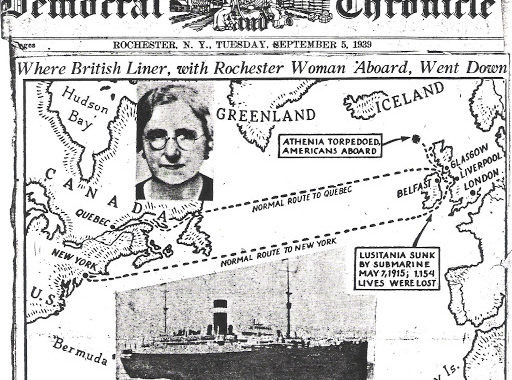It’s time to check back in on the progress of our documentary film, “Athenia’s Last Voyage,” about the sinking of a British passenger ship on the first day of World War II. Since our update early last summer, we’ve completed the film’s script, created a poster and refined our “sizzle reel.”
A sizzle reel is one of many movie-making terms of art that have entered our lexicon. It’s a six- to eight-minute film that helps people see what our documentary is about and how the story will be told, and it is used primarily for raising money (see below).
We are at a crossroads familiar to almost all filmmakers, a junction we never really thought about when we started our project. Simply put, we will need to raise some serious money to complete “Athenia’s Last Voyage.”
For example, we need to search out and acquire the rights to use historic still photos and film clips to bring to life the pre-war era at the end of the 1930’s. These images don’t come cheap. The still photos and film clips that will occupy a third or more of our hour-long documentary could easily cost up to $60,000.
And there are plenty of other expenses. We are also going to need to film reenactments of key scenes, complete animations of ships and several maps, hire a narrator and record the movie’s narration, create and record music and sound effects, and hire an experienced documentary film editor to complete our production. More expenditures are no doubt lurking in the shadows.
So where do we go from here?
We have hired a line producer – Lisa Bruhn. Kay and I had no idea how critical, helpful and encouraging Lisa would prove to be. In a nutshell, the line producer keeps track of the money, develops a realistic budget, handles the accounting and generally makes sure all the financial t’s are crossed and i’s are dotted. Just as Meghan Courtney, our director, is key to the look and feel of the final film, Lisa is key to tracking all the funding, costs, and payouts needed to bring that vision to fruition.
To raise the money for our documentary, we are seeking film-making grants from foundations. Sadly, this pool is shrinking because of Covid-19 concerns. We are encouraging donations and looking for investors through our website: www.atheniaslastvoyage.com, and next spring we will launch a crowdfunding campaign.
So, if you have friends who are interested in World War II and might want to help bring this forgotten story to light, or if you know someone who is looking to invest in an inspiring story of heroism and heartbreak, please direct them to our website. No offer of help is too small.
I thought the most demanding part of making “Athenia’s Last Voyage” would be getting the interviews and writing a script. Now that it is clear the real work has just begun, we are determined as ever to meet these newest demands and tell the story of Athenia’s survivors.
documentary
From Page to Screen, Part 1
Note: This is the first of several occasional blogs about our documentary project, “Athenia’s Last Voyage.”
Not long after Greenleaf Books published my historical novel, Without Warning, in 2017, readers began telling me that the story would make a great movie. When my wife, Kay, and I explored the possibility with a friend’s daughter-in-law (who is in the movie business), she suggested we first make a documentary about the Athenia incident as a way to pique interest in a future feature film.
My goal all along has been to create a wider awareness of the Athenia as a way to honor the memory of my grandmother and so many others who were aboard that ship torpedoed on the first day of World War II. A documentary seemed like an easy next step toward that goal.
Kay and I have been on a steep learning curve ever since. We found a director, Meghan Courtney, eager to take on the project. Last year we filmed interviews with a dozen Athenia survivors and descendants of survivors in Florida and in Halifax, Nova Scotia, where many had come to attend an 80th anniversary commemoration of Athenia’s sinking.
When the dust finally settled, we had more than 180 pages of interview transcripts. It was time to finally write a script for our documentary, using excerpts from the interviews and narration to tell Athenia’s story. That word “story” is the key. To succeed, our script must conform to the basic rules of storytelling. It should enthrall and entertain us from the beginning, to the middle, and all the way through to the end.
We need to engage viewers immediately, with a promise that the story will be well worth the time they spend to watch it. The beginning must quickly establish the documentary’s timeframe and setting, introduce principal characters, and identify what is at stake for the characters.
The beginning is followed by an inciting incident that complicates the characters’ ability to achieve their goal. The incident introduces the middle of the story in which the characters seek again and again to overcome the obstacles that keep them from achieving their goal. This drama builds to a climax, which brings the middle to a close and introduces the ending in which the story comes to a meaningful conclusion.
Good storytellers bring these elements together in ways that seem innovative and unexpected to create memorable novels and screenplays. But these same principles apply to documentary films, with one big exception. In fiction, the storyteller can invent plot twists and characters that serve these basic elements, but a documentarian has to deal with reality. We can’t make up characters or events to suit a plot.
Laying out the bones of our story in a manner that conforms with all the tenets of dramatic storytelling is our next great challenge.
You can follow our progress at our documentary’s website:



